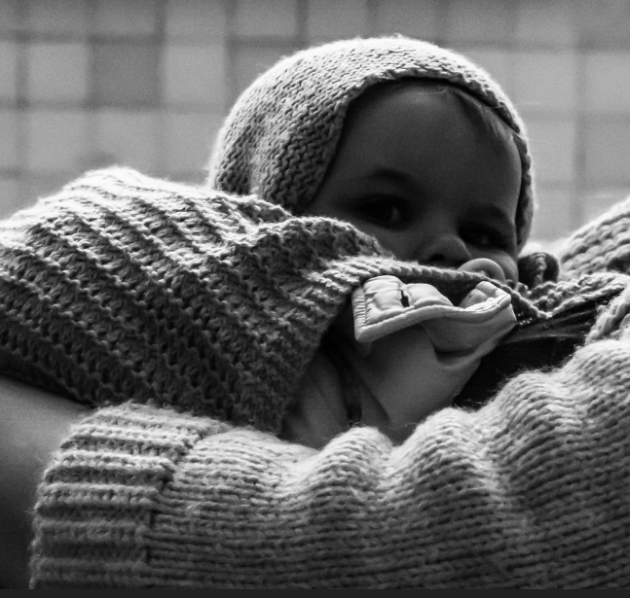
by Sharon Forman
Hearing the Shofar as a Baby’s Cry

Photo credit: Davide Tarozzi
As a Reform Jew who is the descendent of hard-nosed Mitnagdim, European intellectuals who battled the emotional approach of Chasidic Jews, my religious response has always been more cerebral than physical. My early day school education and my mom’s traditional background attempted to teach me that being Jewish was not just an activity for the mind, but also involved eating, singing, and even dancing on certain occasions. Different blessings could accompany experiences involving all of the senses, including tasting a food for the first time, seeing a rainbow, putting on a new pair of shoes, and even using the restroom. However, these hints of Chassidic philosophy did not stick. In our very staid, classical Reform congregation in the South, we did not sway to the prayers, move our bodies in religious school as we studied, or even shake the lulav and etrog with too much gusto on the Festival of Sukkot.
I’m still a bit reserved when worshiping in public. When our rabbi encourages the congregation to “braid arms and hands like a giant challah” at the end of a Shabbat service, I know that he is trying to build community and warmth. For some congregants, this hand-holding may be the only gentle physical contact they share with others all week. It takes a bit of will for me to overcome my prickly instincts in order to reach over to the next row and be a good sport in forming that unwieldy blob of pretend challah.
I may be more Episcopalian than Shaking Quaker when it comes to incorporating the physical into the spiritual, but that doesn’t mean that I can completely live in my head—especially when it comes to being Jewish.
As the holiest time on the Jewish calendar approaches with Rosh Hashanah and Yom Kippur knocking at the door, matters of the body still announce themselves and affect our prayers. Even the most fit and hardy person cannot completely disconnect her physical being from her consciousness, and a growling stomach and caffeine-deprivation-headache on Yom Kippur can interrupt the flow of a silent meditation. When we are fortunate, there is an alignment between our bodies and our loftier thoughts. At these rare moments, we Jews move from being a “people of the Book” to something even more profound.
About a month after the birth of our first child, my husband and I sat in the congregation during Rosh Hashanah services. On maternity leave, I reveled in the quiet peace of being a member of a congregation rather than a rabbi conducting the service. I have to admit that I don’t remember the subject of my colleague’s sermon that day. The memory that has remained me with for seventeen years is the sensation of listening to the shofar and understanding how it affected my entire body.
For centuries, listening to the call of the shofar has been a vital mitzvah (commandment) associated with the New Year’s celebration of Rosh Hashanah and the sacred day of Yom Kippur. Rabbis have interpreted the sound of the ram’s horn to indicate a coronation of God’s throne, a call to war, and a reminder of the ram in the Genesis story of Abraham and the binding of Isaac. On this particular Rosh Hashanah, the sound waves of the shofar blast entered my ears and signaled something different. Instead of telling my brain that I was hearing an ancient, primitive instrument announcing that a new year was beginning, the shofar tricked my brain into thinking that I was hearing a baby’s wail. That cry triggered a series of hormonal responses, and my breasts became completely engorged with milk.
The shofar spoke to me in the most personal terms, masquerading as my vulnerable baby crying for sustenance. At that moment I realized that, in addition to all of the rabbinical meanings it bears, the cry of the shofar was a plea for human compassion. We blow the shofar and cry out to a God that we cannot even begin to fathom and beg for mercy and kindness. We blow the shofar and cry out to one another for decency and love. We are simultaneously both children and parents.
Every year as Rosh Hashanah approaches, my intellect engages with the shofar service whose liturgy proclaims God’s sovereignty over us. I seek metaphors to understand a less personally involved yet existent God. During that one extraordinarily physical moment in a synagogue almost two decades ago I learned what years of rabbinical training could not teach: that the New Year brings with it a visceral plea for tenderness and human decency. Once upon a time the shofar in our synagogues lived on top of the head of a living, breathing, animal. The animal may no longer be alive, but it teaches us a lesson that can elevate us into the highest version of ourselves. And who knows—there may be a tiny bit of Chasid that lives in all of us.
Sharon Forman is a reform rabbi, mother, wife, and a bar and bat mitzvah teacher. She has worked in the field of Jewish education for 23 years and is the author of Honest Answers to Your Child’s Jewish Questions and The Baseball Haggadah: A Festival of Freedom and Springtime in 15 Innings. Her chapter on the intersection between Judaism and breastfeeding can be found in the CCAR’s The Sacred Encounter. Her essays on motherhood have appeared in Literary Mama, Mamalode, Mothers Always Write, The Bitter Southerner, Kveller, Parent.co, and ReformJudaism.org.
The views and opinions expressed in this article are the author’s own and do not necessarily reflect those of Lilith Magazine.